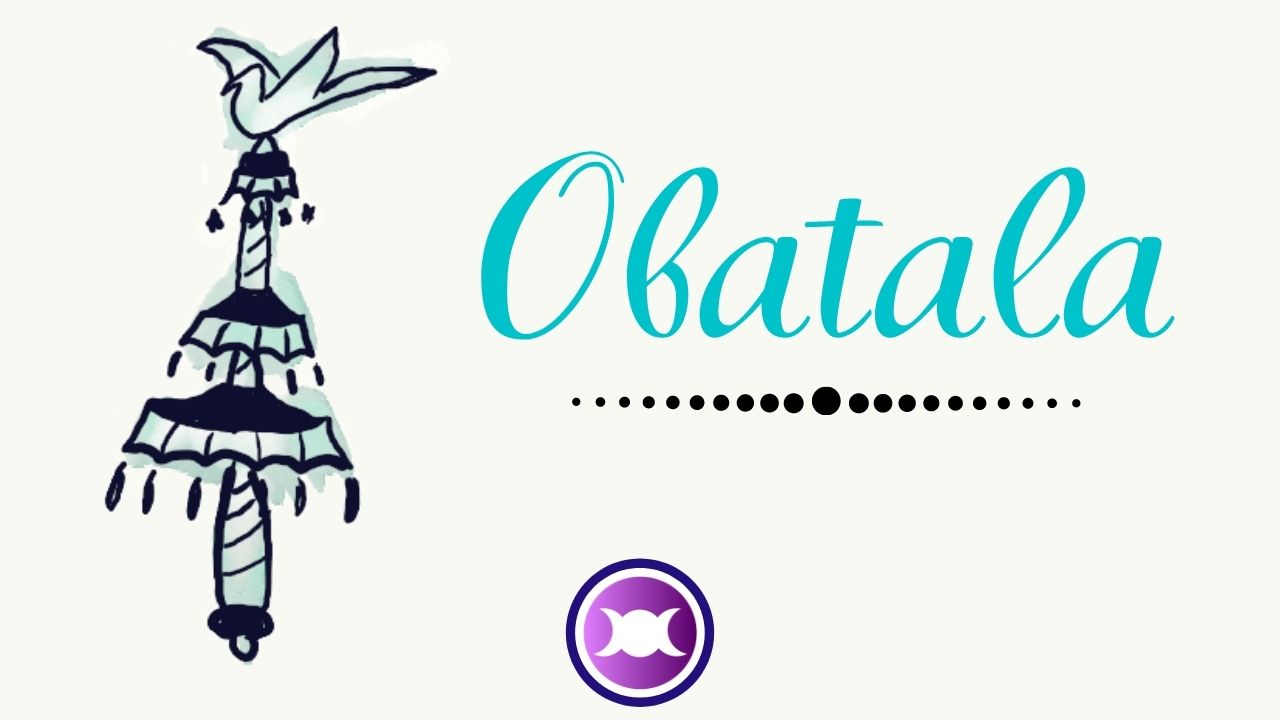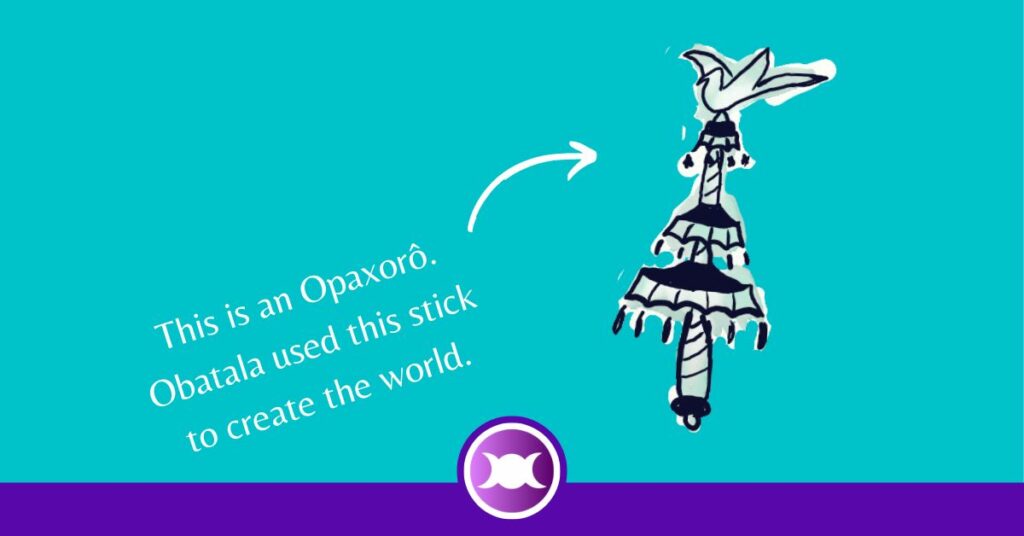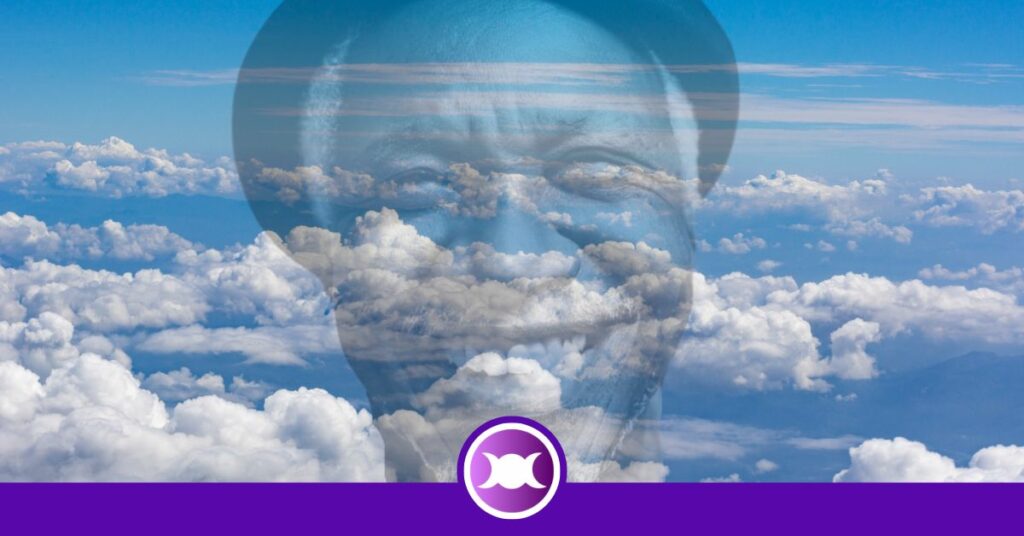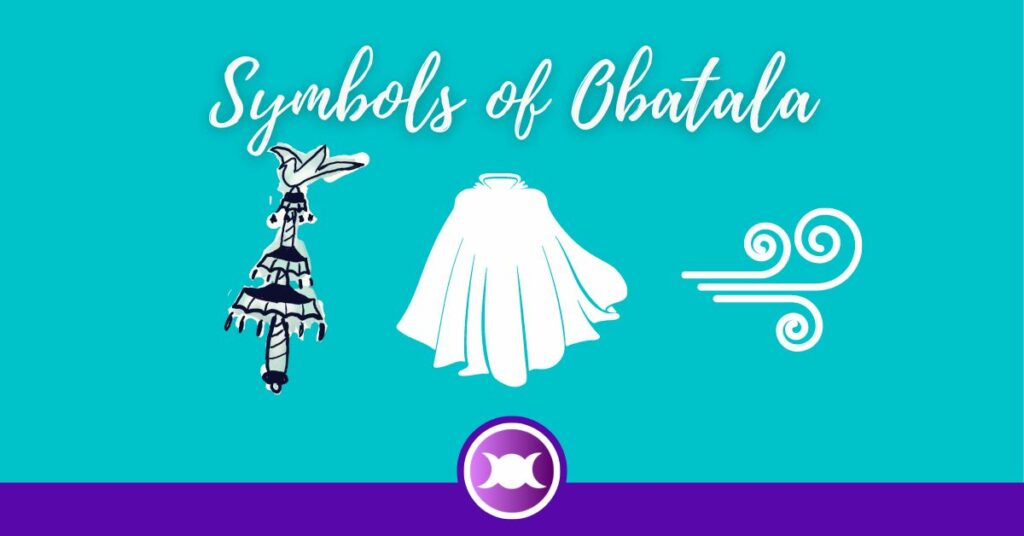Obatala Orisha is one of the oldest Orishas in Yoruba Mythology and he’s known as the King of all. He’s also called Oshala, Oshalufa, Oshaguia, or Orishanla. He created the world we know alongside humankind. In this article, I’ll tell some of his most popular stories and you’ll learn about his symbols, how to make a prayer for him and what he likes to receive as offerings.
He wears white clothes and sometimes he is even depicted as a white-skinned man. He protects all handicapped people and also the albino ones.
He’s venerated in afro-descendant religions such as Santeria, Umbanda, and Candomblé.

Contents
- 1 Obatala creates the world
- 2 Mankind is created from mud – Obatala receives Nana buruku’s help
- 3 The creation of death
- 4 Eshu finds almost all pieces of Obatala
- 5 Obatala’s Offspring
- 6 How did Obatala become the king of the Orishas?
- 7 How did Obatala lose his skin color?
- 8 Obatala Symbols
- 9 Obatala Children
- 10 Prayer to Obatala
- 11 Offerings to Obatala
- 12 Obatala in the Cowrie shells reading
- 13 FAQ
Obatala creates the world
According to Yoruba beliefs, in the beginning, there was only water. This water was not the water we know today. It was lifeless water. The first Orishas already existed and they lived above this water, in the sky. We can imagine they lived in a “celestial plane” and they could visit the water place by going down through a spider web.
So they would do this for fun. Once in a while, the Orishas would go down to play in this water space.
One day, Olorum decided it was time to make something more on that water. So he came up with an idea and ordered Obatala (Orixanla) to execute it. The idea was to create terra firma so the Orishas could walk on this land.
He was given a seashell full of earth (or sand), a pigeon, and a five-fingered hen. He went down from the sky and deposited the earth over the water. Then, he placed the pigeon and the hen on it and both started to spread the earth over the water.
The land had been created! And this land was named Ifé (large abode).

In another version, Olorum is regarded as the Orisha of the Sky and Olokum is the Orisha of the Ocean. In the beginning, only the two of them existed (this is a common motif through other creation stories such as Gaia and Ouranos in Greek Mythology or Nut and Geb in Egyptian Mythology).
They had two children: Obatala and Odudua.
Then, Obatala is instructed by his father to create land over the waters of his mother.
I have already written about this on the main page about Yoruba mythology and the Orishas.
Mankind is created from mud – Obatala receives Nana buruku’s help
Once the world was complete and full of nature and animals, the next task entrusted to Obatala was the creation of people that could live and enjoy the world too.
He tried several times but failed in all of them. He tried to create humans from the air (his own element), but they vanished. Then, he tried creating humans from wood, but they were too stiff and couldn’t move. He tried different elements and materials but none of them worked.
That’s when Nana Buruku appeared and offered some mud. Nana dwells in the mud, so she was actually bringing a piece of her own home. Obatala accepted Nana’s mud and proceeded with the creation of humans. It worked! He was amazed by his creation! However, Nana made a deal with him and told him she could offer some more mud if she could have the humans once they died. He accepted the deal and because of this humans go back to mud when they die. They go to Nana’s care.
I wrote more about this in the article Orishas and the Balance Between Life and Death for Folklore Thursday.
The creation of death
In another story, Obatala is the one that created death. According to this story, he created the humans and they were immortal, just like the Orishas. However, as time passed, humans stopped making offerings to Orishas and thought they were as powerful as their creators.
He was wise and calm but he could also get angry. And he got mad! He couldn’t afford his creation to believe they were superior beings! So he came up with an idea: what if humans could live only for a specific time? That’s when he created Icu, or death as we know it.
Icu became responsible for taking human life however, Icu could not choose when to do it. Obatala decided to limit Icu’s power and entrusted Olorum, his father and the sky, to choose when Icu would be allowed to act. This way, only Olorum knows when a person is going to die and Icu goes and gets the job done.
Eshu finds almost all pieces of Obatala
Eshu and Obatala have a close relationship in many stories. Eshu is usually depicted as his main helper and it’s even said that Eshu learned all he knows from him. There’s a story that tells how Obatala was crushed and had his body separated into thousands of pieces. Eshu is the one that looks for and finds almost all these pieces to revive him.
The story starts when Obatala finds a servant to cultivate his land. This servant makes an exceptional job and the land gets rich and prosperous with different types of food. It’s so beautiful that many people develop envy against him.
One day, as Obatala was slowly walking with his walking stick, some evil people threw a big rock at him. This rock crushed his bones and split him into thousands of pieces. Obatala was gone from this world.
Olorum, his father, saw the event and ordered Eshu, Obatala’s helper and messenger, to look for these pieces all over the world. Eshu departs on a quest to find them and he succeeds. He finds almost all of them and bring them back to Olorum, who uses his magic to bring Obatala back to life.
The missing pieces are still scattered around the world. That’s why people say Obatala is everywhere.
This story reminds us of how Osiris’s body was split into different pieces and Isis found almost all of them and used magic to bring him back to life in Egyptian Mythology.

Obatala’s Offspring
Obatala is the father of lots of Orishas. He’s mainly known as the father of Omulu, the ugliest Orisha of all, and Oshumare, the most beautiful one. These two Orishas are the fruit of his relationship with Nana Buruku, the oldest and wiser of all. I wrote about his story in Nana’s article. In short, he cast a spell on her to be able to control the Eguns (spirits of the dead). He made her fall in love with him. After some time, she decided to have children, but Obatala said it would not be possible. She cast a spell on him and got pregnant, giving birth to Omulu and Oshumare.
Obatala and Yemaya story also points to another child of his. In this story, he meets Yemaya for the first time and falls in love with her. He sends Eshu to discover who she is and invites her to visit his palace. Yemaya visits him in a secret meeting and no one knows what the two of them discussed. After some months, Yemaya gave birth to a girl and Obatala found her to be his daughter because of her birthmarks. He took her into his custody and named her Oshun, the most beautiful Orisha of all.
It’s important to say that there’s another version of the Obatala and Yemaya story. In that one, he is the father of Yemaya.
How did Obatala become the king of the Orishas?
Obatala is an old and wise Orisha. However, there was a moment he wanted to become the king of them all. In order to do so, he looked for a Babalawo and asked for a piece of advice. The Babalawo told him to do an ebó (food offering) using stones and to buy a slave at the local market. He should buy the first slave he could find and he could not complain about anything.
Obatala followed the advice and started preparing the ebó. Then, he visited the market and bought the first slave he found. It was a quiet woman. He took her to his farm and noticed she could not walk properly because she was handicapped. He remembered the words of the Babalawo and did not complain about anything.
He had the idea of leaving the new slave in the crops to scare the birds. He left her there and also left the ebó he was preparing with lots of stones. When the birds arrived, the slave tried to scare them, but she wasn’t able to. So she took some of the stones used in the ebó and threw them. The birds were known as edidé, beautiful red-feathered birds.
As she threw the stones, the birds flew away leaving bright red feathers behind. The slave caught them all and crafted a beautiful crown to give to Obatala. She delivered the crown and he wore it during a party of the other Orishas that night.
All the other Orishas were amazed by the looks of Obatala. He was wearing his traditional white and clean clothes and also wearing his new and superb red crown. Because of this, he received the title of king of the Orishas, or the Great Orisha: Orishanla!
How did Obatala lose his skin color?
There’s a story that explains how Obatala lost his skin color and became albino. In this story, we have a quarrel between Obatala and his messenger, Eshu. It starts when the two of them started to argue about who was the oldest Orisha of all. Obatala, as king and creator of mankind, knew it was him. Eshu complained saying he also existed before all of Obatala’s creation.
Their argument became so violent that they asked Ifá for advice and Ifá said they would have to fight. All the Orishas knew that no one could defeat Eshu in a fight because he was extremely tricky and he could use all sorts of magical powers.
The duel started and they had a melee fight. Obatala threw Eshu on the floor three times in a row just using his hands. Although he was old, he was really strong. At a specific moment, Eshu took his gourd and blew a magical white powder that was inside it all over the place. This powder formed a white smoke that covered everything. When the smoke came down, it removed all of Obatala’s skin color, making him totally white!
The duel continued and Obatala defeated Eshu before he could use any other magical trick. After this, Obatala was truly venerated as a king and the most powerful Orisha! He also became the protector of people who shared similar characteristics as him such as pale skin color (albino people), hunchbacked people (because of his age, he’s hunchbacked), and handicapped people too.
Obatala Symbols
Obatala is commonly depicted with white symbols or white things in general. He can even be depicted as a white-skinned Orisha. As he is an old Orisha, it’s common to see him using a walking stick too. Apart from this, he is symbolized by the air, so wind or even the sky can represent him. He usually holds his Opaxorô too, a stick symbolizing the creation of the world. Check below the main symbols of Obatala:
- Opaxorô;
- White clothes;
- The air.

And the animals that symbolize Obatala are:
- Dove;
- Elephant.
As Obatala is the air, he is everywhere and we all depend on him to survive. It’s interesting to notice that doves represent him because they are white and they are able to fly, so it’s like him in the air. The elephant, however, represents him because it moves slowly and it’s impressively wise.
Obatala Children
You know we are all children of an Orisha in one way or another. If you’ve been trying to discover which Orisha rules your head, you must pay attention to a lot of signs in your life. The Obatala children manifest many of his features in their daily lives. They tend to be calm people, do things slowly, pay attention to details, and appreciate silence.
Other characteristics of his children include the ability to use words to solve problems and situations, the will to help people in difficult situations, and also the ability to make fair decisions.
By analyzing Obatala’s archetype and checking his children, we can also identify a shadow aspect that is very common among all of them. They are complainers. This happens because they easily see how wrong and unfair our society has become and they feel the need to expose it to everybody. When this shadow is not controlled, they tend to start complaining about everything… all the time.
Prayer to Obatala
Learn a powerful prayer to Obatala below. You can recite it to ask for his blessings. His day is Friday, so the best time to pray for him is on Friday mornings.
Babá Obatala, as this new day begins I come to ask for peace, joy and your great energy!
Cover me with your light and destroy the darkness that crosses my paths and disturbs my peace.
Wrap me in your white cloth of peace every moment of my day.
Epà Babá!
Babá means father.
Offerings to Obatala
The best offerings to Obatala include some flowers and herbs. You can offer him them and ask for enlightenment, tranquility, wisdom, health, and peace. He does things slowly so you may notice that the things you ask him can come gradually into your life. Check this list of offerings to Obatala e choose the best ones for you to offer him:
- Boldo;
- Bay leaves;
- White roses;
- Mint leaves;
- Yam;
- Chamomile.
Offering to Obatala recipe: Yam balls
There’s an offering to Obatala that consists of making yam balls and asking him to help you to balance your feelings or to give you enthusiasm and creative energy. The way you make this recipe changes depending on what you want to ask him. I’ll give you the details below.
To make this offering to Obatala, you are going to need:
- 3 pieces of yam;
- Some honey;
- Some cassava flour;
- A clay pot to serve;
- Some water;
- Some boldo leaves.
Start by adding some cassava flour and honey together. Add some honey little by little while you mix it with the cassava flour using your own hands. Keep mixing them together until they form some sweet dough.
Now you must prepare the yam. If you want Obatala to help you balance your emotions you must cook them in water. If you want him to give you enthusiasm and creative energy, you must bake them on fire only.
With the yam ready, you must peel them and wash them so they won’t have earth on them anymore. Smash the 3 yams into one and create, with your hands, 7 small yam balls.
Take the clay pot and put boldo leaves on the bottom of it. Now add all the sweet dough you made with cassava flour and honey. Place the seven yam balls on them and pour some honey forming a spiral from the inside out.
Leave the offering to Obatala under a tree. It’s done.
Obatala in the Cowrie shells reading
When using cowrie shells reading for divination you can come across the Odu Odi, the Odu in which 7 shells are open and 9 are closed. In this Odu, Obatala and Omulu come together to give a “no” answer.
Obatala warns you that changes are coming and you must accept them for they are necessary – even though they can be unpleasant.
Obatala also manifests as Oshaguia in the Odu Egi Onilé, in which 8 shells are open and 8 shells are closed. This time the answer is positive and negative at the same time. Oshaguiã tells you to take advantage of the moment and connect with elevated energies. He also warns you to avoid negative thoughts and forget issues related to revenge or hate.
There’s also another appearance of Obatala in the Cowrie shells reading. In the Odu Ofun, in which 10 shells are open and 6 are closed. This time he manifests as Oshalufã and the message is positive. He tells you that the energies are all favoring you! It’s a moment of luck and prosperity.
FAQ
What does Obatala symbolize?
Obatala symbolizes the air and creation in general. He also symbolizes kingship as he is the king of Orishas.
What does Obatala help with?
Obatala helps with achieving balance, peace, and tranquility. He blesses and protects all who worship him, mainly people that share some of his characteristics such as being hunchbacked, old, handicapped, or albino.
Who is Obatala?
Obatala is the Orisha that created the world and humans. He is one of the oldest Orishas of all.

Ok… much of this resonates with what I’m doing now… my Birth day is 12-12, I’m Epileptic, Sage and Mint and Yams (sweet potatoes) are just a few things I already grow in my garden..I am a Gullah-GeeChee. The name I was given by my Elders is RaMah which means Thunder.. and I always have been advocate for our students as I was volunteer teachers aid all while my children were in school. So would I be safe to say I have found my Orisha ?
Hi, RaMah! Sorry for the delay!
SO… probably YES! I suggest you do a simple ritual before sleeping to ask your Orisha to manifest in a dream.
Write down everything you dream and then analyze the symbols and images in case they are not clear. Probably you’re going to see lots of white and blue things, the sky, and birds…